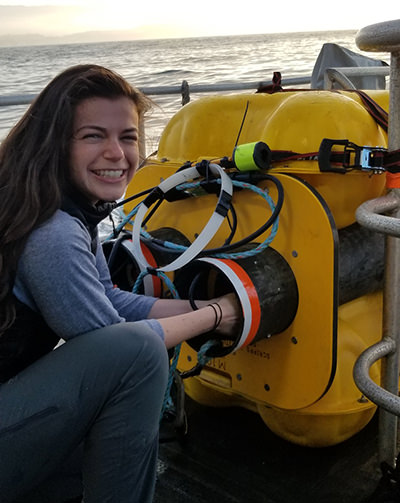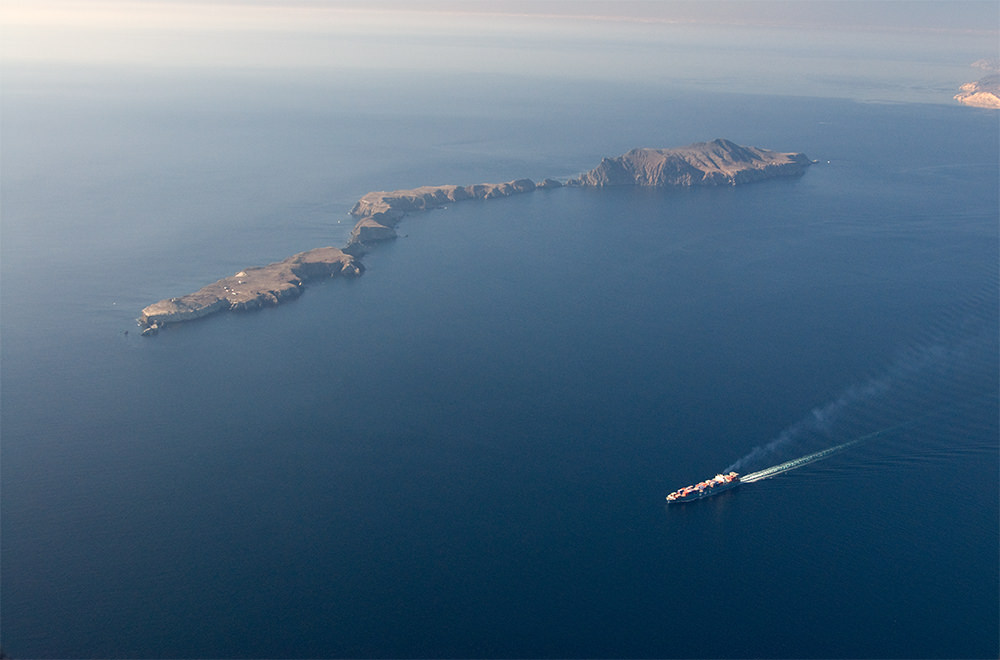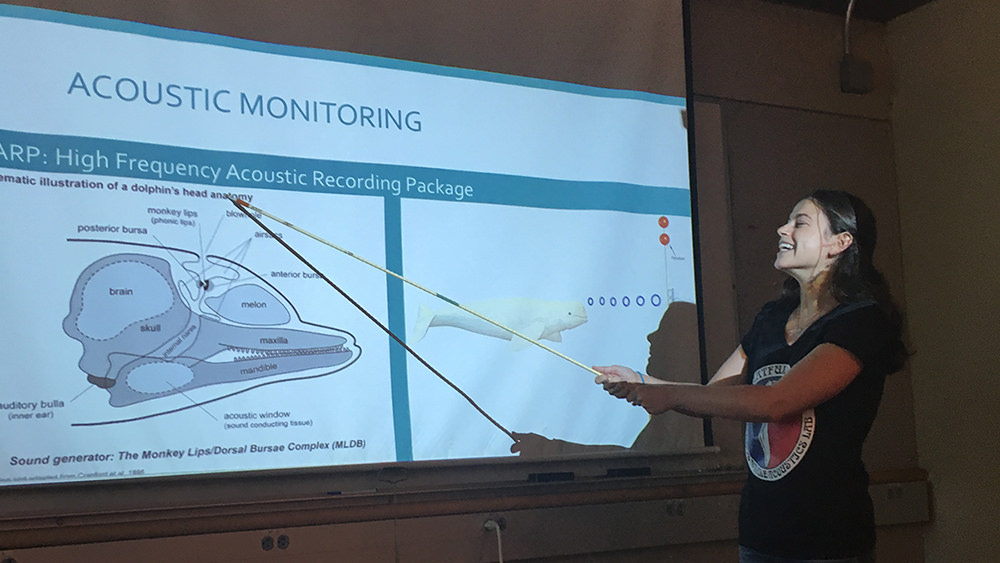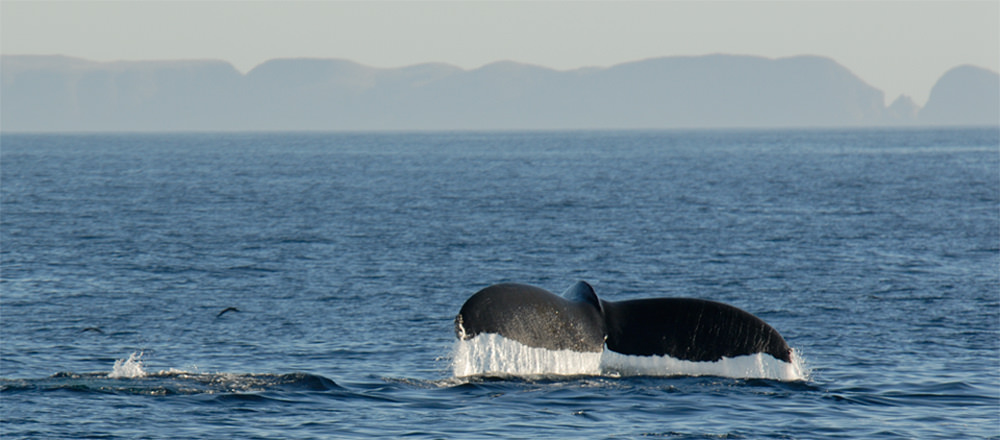Whales and ships: Foster Scholar Vanessa ZoBell studies whether slower ships improve whale communication in Channel Islands National Marine Sanctuary
By Yaamini Venkataraman
December 2019
The ocean teems with intriguing sounds. Beneath the crashing waves, a sea bass bleats. Snapping shrimp provide a delicate, rhythmic background for charismatic humpback whale calls that boom through the water. Humans also make sounds that add to the mix: for example, as cargo ships deliver necessary goods between ports, they add their own low pitch track. All these sounds coexist: how do we ensure they are a symphony and not a cacophony?

This question is what Dr. Nancy Foster Scholar Vanessa ZoBell actively seeks to answer. As a second year Ph.D student at the Scripps Institution of Oceanography at the University of California, San Diego, ZoBell studies sounds in the ocean, or marine acoustics. Since sound travels farther in the ocean than light, many marine organisms use sound to communicate, forage, and navigate. Studying acoustics, ZoBell can understand what’s happening in the ocean without having to be under the waves. “I always liked acoustics because it was a non-invasive approach. You didn’t have to poke anything to learn about it. You just have to listen,” ZoBell says.
She got an early start in acoustics — in high school, ZoBell did a whale acoustic research internship at the Scripps Institution of Oceanography in San Diego. After studying bird acoustics in college, she applied to graduate school and found her way back to the same lab where she was a high school intern. For her Ph.D., she uses acoustics to study how human activity influences marine organisms. She examines how ship noise affects marine systems inside and outside of Channel Islands National Marine Sanctuary.
A hub for ships and whales
Channel Islands National Marine Sanctuary is not only home to diverse marine life, but also economically important shipping lanes. These shipping lanes overlap important feeding grounds of endangered or threatened blue, fin, and humpback whales. As commercial vessels pass through these feeding grounds, they can collide with whales. These ship strikes can be fatal, and NOAA is working hard to prevent them.
One way NOAA can prevent ship strikes is by creating whale advisory zones in critical whale habitats. Since 2008, NOAA has implemented a whale advisory zone that includes sanctuary waters from May to November, broadcast through the U.S. Coast Guard’s Local Notice to Mariners. The zone recommends that ships heavier than 300 gross registered tons voluntarily slow down to 10 knots or less. When ships slow down, any collisions they have with whales have a smaller chance of delivering a lethal strike. In addition to advisory zones, Channel Islands National Marine Sanctuary started working with three Southern California air district agencies in 2014 to implement an incentive program. The program encourages ships to slow down as they pass through the sanctuary to reduce the risk of fatal ship strikes and air pollution emitted by the ships.
“We have focused on the impact of ship strikes on [blue, fin, and humpback] whale populations for our Vessel Speed Reduction efforts,” says Jessica Morten, resource protection specialist with Channel Islands and Cordell Bank national marine sanctuaries. “Understanding the acoustic impacts of shipping on these endangered whales is another important piece to implementing effective policy that can protect them.”

Are slow ships quiet ships?
While slower ships burn less fuel and thus emit less pollution, they still make noise that can interfere with and sometimes mask marine mammal communication. According to ZoBell, ship speed may also be a good indicator of how much noise the vessel produces. Ship noise is mainly driven by propellers, which are optimized to perform the most efficiently, and the most quietly, at specific speeds. Speed changes can reduce their efficiency and create more noise. Now, ZoBell is pairing ship speed information with noise information to see when slower ships really are quieter, and if they’re quiet enough for marine life. Using data from before and after the incentive program was implemented, ZoBell can also determine how the incentive program plays a part in reducing ship noise.
For this research, ZoBell continues to collect ship noise data with a recording device placed 1,600 feet below the surface. This device has been in the same location for 10 years, providing ZoBell with over 10,000 shipping recordings. Using the Coast Guard’s vessel traffic information for each ship, she can track the ship through the sanctuary and calculate its speed. Since the incentive program only started in 2014, ZoBell can use the vessel speed and noise information to see if the incentive program has also helped reduce shipping noise within the sanctuary.

Even if slow ships are quiet ships, are they quiet enough? ZoBell is looking at noise created within the range of tones, or frequencies, that animals like whales use to communicate. This will help her understand how ships could impact the whales’ ability to hear each other. Using mathematical models, ZoBell can compare the distances over which whales can hear each other when ships make different levels of noise. Not only can she compare volume levels of whale calls and ship noise, but she can also calculate how far both types of sound travel. Then, she can estimate the distances over which calling whales can be drowned out by noise from the busy traffic lanes in the sanctuary. By comparing how much noise ships produce at different speeds, and comparing other factors, she can piece together when slower ships are quieter, when animals are more likely to hear one another, and over what distances this remains true.
“We can say slower ships are quieter, but how quiet is quiet enough for a blue whale?” ZoBell asks. “If we know the distance over which blue whales need to hear one another, we can estimate how much a ship going a certain speed through the same area can impact the whales’ ability to communicate.”

Whales and ships
Although anthropogenic noise is often a problem for marine life, it’s also a problem with a solution: as soon as you quiet a source of noise, the problem is minimized. ZoBell believes that by working with Channel Islands National Marine Sanctuary, nonprofits, and shipping companies, her work can support efforts to turn down the volume. Communicating the importance of sound in marine systems is a crucial piece of this work. Working with the non-profit California Ocean Alliance, she teaches high schoolers in the Monterey Bay area about noise impacts on marine environments.
“I worked with [high school students] who gave a presentation on ship noise and humpback whales,” ZoBell says. “At first, their title was ‘Whales vs. Ships,’ [but] I always think of it as whales and ships. Can we figure out how they can coexist, because we really need both.”
Yaamini Venkataraman is a volunteer social media intern for NOAA’s Office of National Marine Sanctuaries and a graduate student at the University of Washington.

